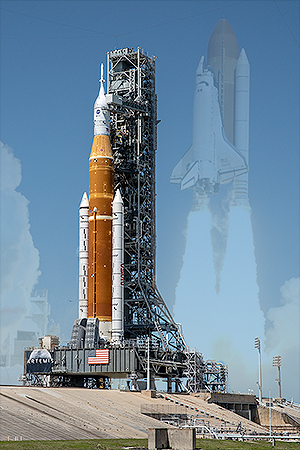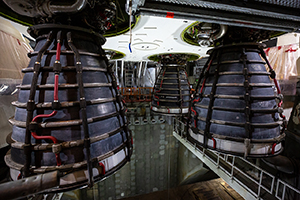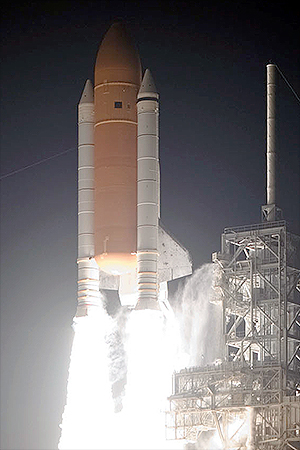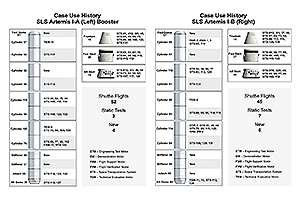August 24, 2022 — More than a decade after NASA landed its last space shuttle, major parts from all five of the retired winged orbiters are ready to launch again — this time on a mission to the moon.
Components that previously flew on 83 out of the 135 space shuttle missions have been assembled into new vehicles: the Space Launch System (SLS) and its Orion spacecraft.
"While we have tested each of these subsystems, whether they are the boosters, the RS-25 engines [or] the Orion main engine ... it is the first time we are going to operate these together is one integrated vehicle," said Mike Sarafin, Artemis mission manager at NASA Headquarters, during a pre-launch press conference.
The Artemis I mission is the first test flight of the SLS. The more-than-a-month-long mission will send an uncrewed Orion on a trip far beyond the moon into a distant retrograde orbit before the capsule returns to Earth. The journey will be the farthest into space that a human-rated spacecraft has ever traveled, pushing the Orion to its limits before future missions fly with astronauts on board.
As directed by Congress in 2010, NASA developed its next-generation heavy-lift rocket and crew capsule with "space shuttle-derived components ... that use existing United States propulsion systems, including liquid fuel engines, external tank or tank-related capability and solid rocket motor engines."
The result is an SLS powered by four modified space shuttle main engines and two extended shuttle solid rocket boosters. Orion is also powered using an engine that was previously maneuvered the shuttle in orbit. All three elements of the Artemis I SLS and Orion have flight histories that date back decades, as far back as August 1984.
Renamed, reconfigured, reflown
When the countdown to the Artemis I launch enters its final seconds, the first sign of the SLS coming to life will be the ignition of the four RS-25 engines at the base of its core stage. Built by Aerojet Rocketdyne, the RS-25 was originally referred to as the Space Shuttle Main Engine (SSME).
"We're using engines here from shuttle, but the engines have new controllers on them," said Chris Cianciola, SLS program deputy manager at NASA's Marshall Space Flight Center, in response to a question from collectSPACE.
In addition to the development of a new controller and software, the four engines flying on Artemis I also have additional insulation on their nozzles to protect them from the exhaust of the solid rocket boosters.
All four of the RS-25 engines installed on the Artemis I core stage — serial numbers 2045, 2056, 2058, and 2060 — have history with the space shuttle flying into low-Earth orbit.
Engine 2045, installed in position 1 (at top left when viewed from below), first flew on 12 shuttle missions spanning 13 years, from 1998 through 2011. Among the flights it helped launch was Mercury astronaut John Glenn's return to flight (STS-95); the 100th space shuttle flight (STS-92); the delivery of Japan's exposed facility to the International Space Station (STS-127); and the final shuttle mission (STS-135).
In position 2 (bottom left), engine 2056 earlier launched on four shuttle missions, including the installation of the Quest airlock for the International Space Station (STS-104); the fourth Hubble Space Telescope servicing mission (STS-109) and the two return to flight missions after the loss of space shuttle Columbia (STS-114 and STS-121).
Engine 2058 in position 3 (bottom right) was part of six shuttle missions, including the delivery of the U.S. Harmony node and Japanese Kibo laboratory for the International Space Station (STS-120 and STS-124), as well as the final flight of the orbiter Discovery (STS-133).
The fourth RS-25 flying on Artemis I, engine 2060, was flight proven on three space shuttle launches, including STS-131, a station resupply flight; and two of the missions flown with engine 2045 — STS-127 and STS-135.
Unlike their use on the shuttle, the Artemis I RS-25 engines will not be recovered for reuse. The core stage's size, as well as its altitude and speed at engine cutoff, made recovery impractical without making a significant sacrifice in cargo-carrying capability. The core stage will break apart on reentry and drop any surviving parts into the Pacific Ocean.
Case history
At T-0 in the countdown, about six seconds after the four RS-25 engines fire, the two side-mounted solid rocket boosters ignite. Together, the boosters and engines produce more thrust at liftoff than any prior U.S. rocket launched in history.
Manufactured by Northrop Grumman, the SLS boosters are the largest, most powerful solid propellant motors ever built for flight. Based on the shuttle boosters, the major difference between the shuttle and SLS hardware is the addition of a fifth solid propellant segment to the four-segment shuttle booster, allowing SLS to send more weight to trans-lunar injection than the shuttle lofted to low-Earth orbit.
For Artemis I, the SLS solid rocket boosters were built up from aft skirts, thrust vector control elements, metal cases and forward structures that were previously flown with the shuttle.
The left (I-A) and right (I-B) side boosters include hardware previously used in the launch of 73 shuttle missions, including all but three of the flights flown by the four Artemis I RS-25 engines.
The oldest component, the aft skirt on the I-A booster, first flew with the maiden flight of the space shuttle Discovery, STS-41D, in 1984. The same part also flew on the ill-fated last launch of orbiter Columbia (STS-107) and most recently with Discovery on STS-128.
That last flight may carry significance if Artemis I lifts off on its first launch attempt, currently scheduled for Monday (Aug. 29). STS-128 was 23 seconds into its launch to the International Space Station on that same day in 2009, 13 years ago.
The two boosters' shuttle history also includes STS-31, the mission that deployed the Hubble Space Telescope (a cylinder on I-B) and STS-88, the first flight to dock to the International Space Station (the forward skirt on I-A).
Like the RS-25 engines, the SLS boosters will not be recovered after they separate from the core stage at 2 minutes and 12 seconds into flight. Falling from about 142,000 feet (43.3 km), the boosters will splashdown and be allowed to sink into the Atlantic Ocean roughly five and a half minutes after their launch.
Go for (lunar) orbit
"Our reuse of the OMS-E, the shuttle's orbital maneuvering system engine, is our main engine," said Howard Hu, Orion Program manager at Johnson Space Center in Houston.
Part of the European-built service module, the powerhouse for the capsule, the Orion main engine was first built by Aerojet Rocketdyne to serve as an orbital maneuvering system engine for the shuttle orbiter. As one of two such engines on each of the winged spacecraft, the OMS-E provided the thrust to enter, circularize and transfer between orbits, as well as to rendezvous, deorbit and execute aborts.
On Orion, the main engine provides nearly 6,000 pounds of force and is able to swivel from side to side, as well as up and down.
"We've not only replaced all of the soft goods that came with the OMS-E engine we got from the shuttle program, we've also done extensive testing and recertified it [for SLS]," said Hu.
The Artemis I Orion main engine (serial no. 111) first flew on 19 shuttle missions between 1984 and 2002. It launched with Challenger carrying the first seven-person crew (STS-41G), put Atlantis into orbit for the first time (STS-51J) and like one of the I-B booster cylinders, aided the deploy of the Hubble Space Telescope.
The Orion main engine will be discarded with the European service module when it separates from the capsule prior to Orion reentering Earth's atmosphere at the end of the mission.
With Artemis goes the shuttle
Artemis I is not the only mission that will fly with parts used on the space shuttle.
The next three SLS missions, Artemis II through Artemis IV, will be powered by 14 flight-proven RS-25 engines and two new engines assembled from shuttle-era components. NASA has awarded Aerojet Rocketdyne with a contract to then build new, expendable RS-25 engines for use beginning with Artemis V.
Similarly, Northrop Grumman will support the Artemis II and Artemis III missions with shuttle-era hardware, before producing new assets for Artemis IV through Artemis VIII. Beginning with Artemis IX, the company plans to introduce Booster Obsolescence and Life Extension (BOLE) boosters that will replace the steel cases used for the space shuttle with composite cases and upgraded structures.
Shuttle-legacy OMS engines will be used with Orion through the first six missions, after which Aerojet Rocketdyne will begin providing new Orion main engines for flights though 2032.
Although most of the flight-qualified hardware remaining after the space shuttle program was set aside for use with the SLS, flown examples of the space shuttle main engine, solid rocket boosters and orbital maneuvering engines are preserved by museums, including the National Air and Space Museum in Washington, D.C. and California Science Center in Los Angeles. |
|

NASA's Artemis I mission will lift off using parts that previously flew on multiple space shuttle flights. (NASA/collectSPACE)

The four Artemis I Space Launch System RS-25 engines first flew on 21 space shuttle missions. (NASA/Cory Huston)
Artemis I RS-25 engine flight history
|
STS-89
STS-95
STS-92
STS-102
STS-105
STS-110
STS-113
STS-121
STS-118
STS-127
STS-131
STS-135 |
|
Endeavour
Discovery
Discovery
Discovery
Discovery
Atlantis
Endeavour
Discovery
Endeavour
Endeavour
Discovery
Atlantis |
|
Jan. 22, 1998
Oct. 29, 1998
Oct. 11, 2000
March 8, 2001
Aug. 10, 2001
April 8, 2002
Nov. 23, 2002
July 4, 2006
Aug. 8, 2007
July 15, 2009
April 5, 2010
July 8, 2011 |
|
STS-104
STS-109
STS-114
STS-121 |
|
Atlantis
Columbia
Discovery
Discovery |
|
July 12, 2001
March 1, 2002
July 26, 2005
July 4, 2006 |
|
STS-116
STS-120
STS-119
STS-124
STS-129
STS-133 |
|
Discovery
Discovery
Discovery
Discovery
Atlantis
Discovery |
|
Dec. 9, 2006
March 15, 2009
Oct. 23, 2007
May 31, 2008
Nov. 16, 2009
Feb. 24, 2011 |
|
|
|
Endeavour
Discovery
Atlantis |
|
July 15, 2009
April 5, 2010
July 8, 2011 |

|

One of the two solid rocket booster aft skirts that launched STS-128 on Aug. 29, 2009, is set to fly again with the left side Artemis I solid rocket booster 13 years later. (NASA)

The left (I-A) and right (I-B) side solid rocket boosters flying on Artemis I include hardware that was previously used in the launch of 73 space shuttle missions. (NASA/Northrop Grumman)
Artemis I Orion main engine history
|
STS-41G
STS-51J
STS-61B
STS-27
STS-30
STS-33
STS-31
STS-41
STS-37
STS-43
STS-44
STS-45
STS-46
STS-101
STS-106
STS-98
STS-104
STS-110
STS-112 |
|
Challenger
Atlantis
Atlantis
Atlantis
Atlantis
Discovery
Discovery
Atlantis
Atlantis
Atlantis
Atlantis
Atlantis
Atlantis
Atlantis
Atlantis
Atlantis
Atlantis
Atlantis
Atlantis |
|
Oct. 5, 1984
Oct. 3, 1985
Nov. 26, 1985
Dec. 2, 1988
May 4, 1989
Nov. 22, 1989
April 24, 1990
Oct. 6, 1990
April 5, 1991
Aug. 2, 1991
Nov. 24, 1991
March 24, 1992
July 31, 1992
May 19, 2000
Sept. 8, 2000
Feb. 7, 2001
July 12, 2001
April 8, 2002
Oct. 7, 2002 |

|
|
